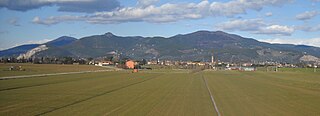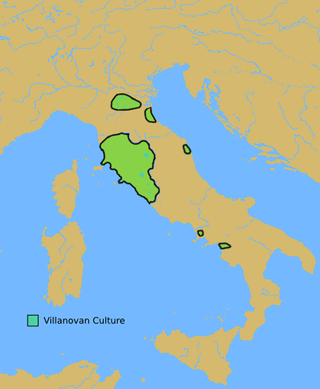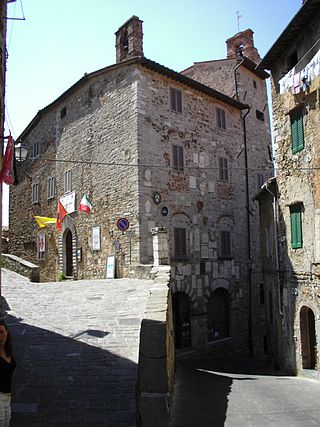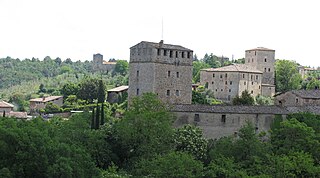
The province of Grosseto is a province in the Tuscany region of Italy. Its capital is the city of Grosseto. As of 2013 the province had a total population of 225,098 people.

Volterra is a walled mountaintop town in the Tuscany region of Italy. Its history dates from before the 8th century BC and it has substantial structures from the Etruscan, Roman, and Medieval periods.

The province of Pisa is a province in the Tuscany region of central Italy. Its capital is the city of Pisa. With an area of 2,448 square kilometres (945 sq mi) and a total population of 421,642, it is the second most populous and fifth largest province of Tuscany. It is subdivided into 37 comuni.

Certaldo is a town and comune of Tuscany, Italy, in the Metropolitan City of Florence, in the middle of Valdelsa. It is about 35 kilometres (22 mi) southwest of the Florence Duomo.
Clusium was an ancient city in Italy, one of several found at the site. The current municipality of Chiusi (Tuscany) partly overlaps this Roman walled city. The Roman city remodeled an earlier Etruscan city, Clevsin, found in the territory of a prehistoric culture, possibly also Etruscan or proto-Etruscan. The site is located in northern central Italy on the west side of the Apennines.

The Villanovan culture, regarded as the earliest phase of the Etruscan civilization, was the earliest Iron Age culture of Italy. It directly followed the Bronze Age Proto-Villanovan culture which branched off from the Urnfield culture of Central Europe. The name derives from the locality of Villanova, a fraction of the municipality of Castenaso in the Metropolitan City of Bologna where, between 1853 and 1855, Giovanni Gozzadini found the remains of a necropolis, bringing to light 193 tombs, of which there were 179 cremations and 14 inhumations.

Asciano is a comune and hill town in the province of Siena in the Italian region Tuscany. It is located at the centre of the Crete senesi between the river Ombrone and the torrent Copra, some 30 kilometres (19 mi) southeast of the town of Siena by rail.

Vetulonia, formerly called Vetulonium, was an ancient town of Etruria, Italy, the site of which is probably occupied by the modern village of Vetulonia, which up to 1887 bore the name of Colonnata and Colonna di Buriano: the site is currently a frazione of the comune of Castiglione della Pescaia, with some 400 inhabitants.

Massa Marittima is a town and comune of the province of Grosseto, southern Tuscany, Italy, 49 km NNW of Grosseto.

Populonia or Populonia Alta today is a frazione of the comune of Piombino. As of 2009 its population was 17. It is a member of the I Borghi più belli d'Italia association. Populonia is especially noteworthy for its Etruscan remains, including one of the main necropolis in Italy, discovered by Isidoro Falchi.

Campiglia Marittima is a comune (municipality) in the Province of Livorno in the Italian region Tuscany, located about 90 kilometres (56 mi) southwest of Florence and about 60 kilometres (37 mi) southeast of Livorno. It is a member of the I Borghi più belli d'Italia association.

Murlo is a comune (municipality) in the Province of Siena in the Italian region Tuscany, located about 70 kilometres (43 mi) south of Florence and about 20 kilometres (12 mi) south of Siena.

San Casciano dei Bagni is a comune (municipality) in the Province of Siena in the Italian region of Tuscany, located about 110 km (68 mi) southeast of Florence and about 70 km (43 mi) southeast of Siena. It is a member of the I Borghi più belli d'Italia association.

Stigliano is a village in Tuscany, Italy, a frazione (subdivision) of the comune of Sovicille, in the province of Siena.

Civitella Marittima is a village in southern Tuscany, in central Italy, administratively part of the municipality of Civitella Paganico, of which it houses the seat. It is located in the valley of the Ombrone river, at 329 metres above sea level. In 2001 it had a population of 517 inhabitants.

Paganico is a village in the province of Grosseto, in southern Tuscany, central Italy. It is a frazione of the comune of Civitella Paganico. It lies in the valley of the Ombrone river, at 66 meters above the sea level. In 2011 it had a population of 961 inhabitants.
The Pari Center for New Learning is a non-profit educational center located in the village of Pari in Civitella Paganico of the Province of Grosseto, Italy. The center was directed by F. David Peat, who co-authored the book Science, Order, and Creativity with theoretical physicist David Bohm. The center has hosted, with the support of its renowned fellows from academia and the arts, the academy Accademia dei Pari. It hosts international conferences on the role of trust and ethics in the world of economics and business, and conferences on the relationship between religion and science.

Dogana is a village in Tuscany, central Italy, administratively a frazione of the comune of Civitella Paganico, province of Grosseto. At the time of the 2001 census its population amounted to 38.

Monte Antico is a village in Tuscany, central Italy, administratively a frazione of the comune of Civitella Paganico, province of Grosseto, in the area of the Ombrone Valley. At the time of the 2001 census its population amounted to 33.

Venturina Terme is a frazione of the comune of Campiglia Marittima . Formerly known as Venturina, it was renamed as Venturina Terme since 1 January 2014 for the importance of its thermal activities.























